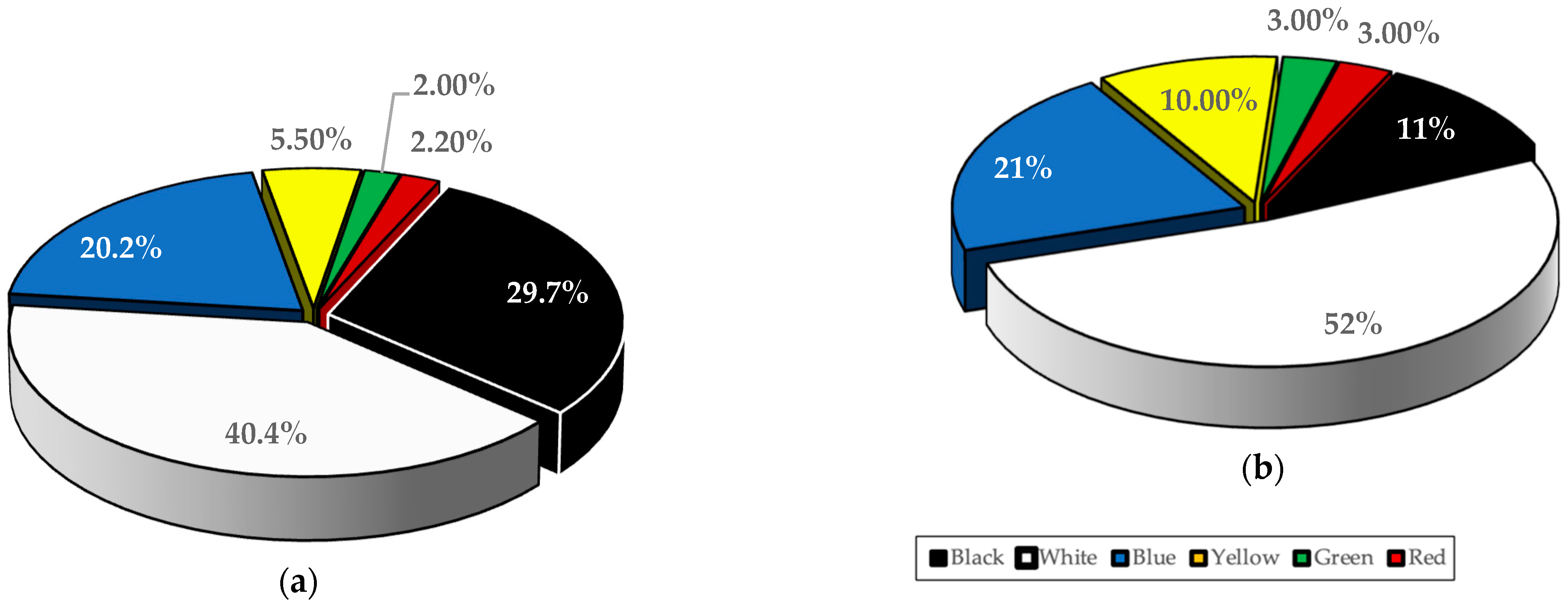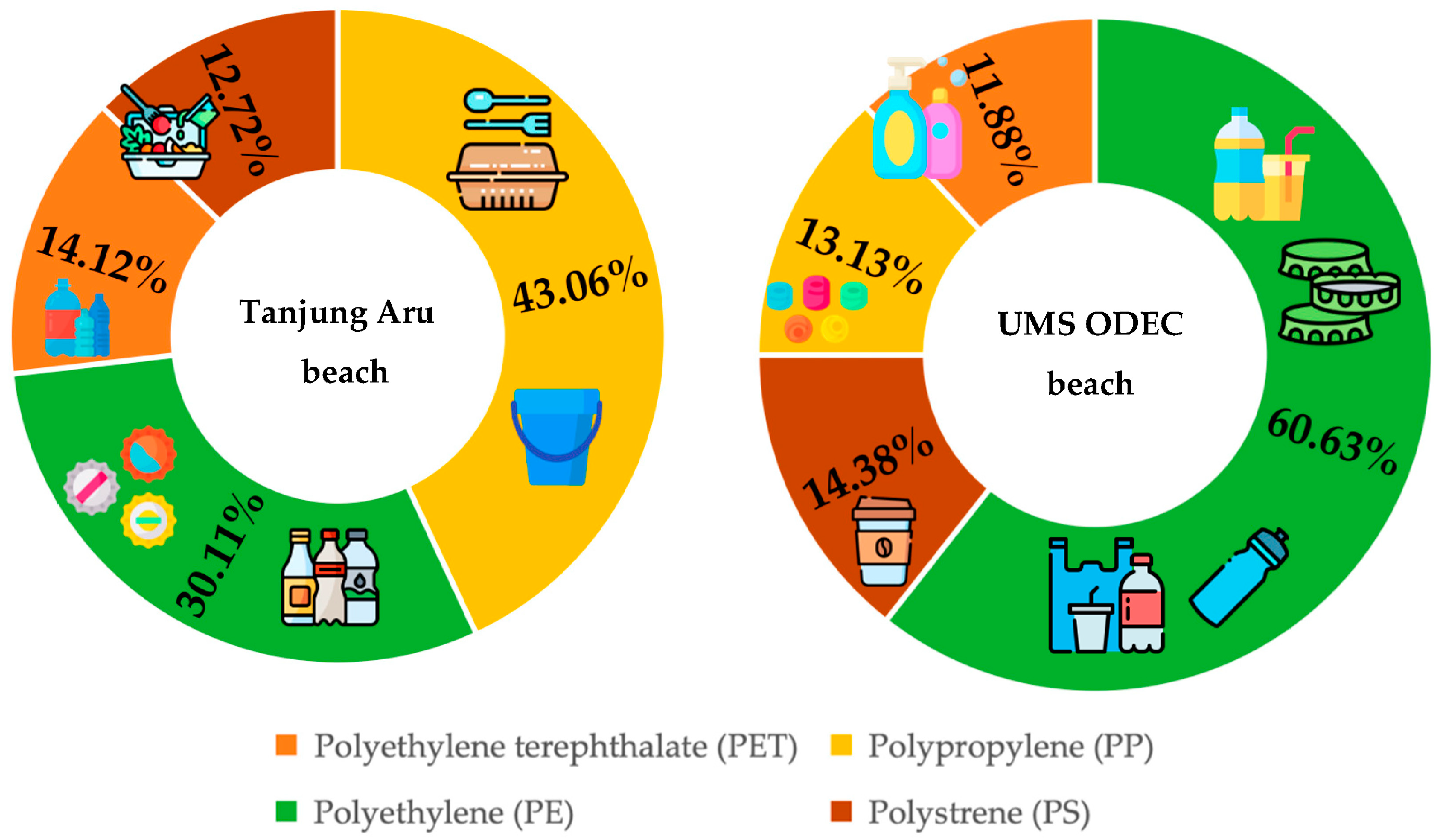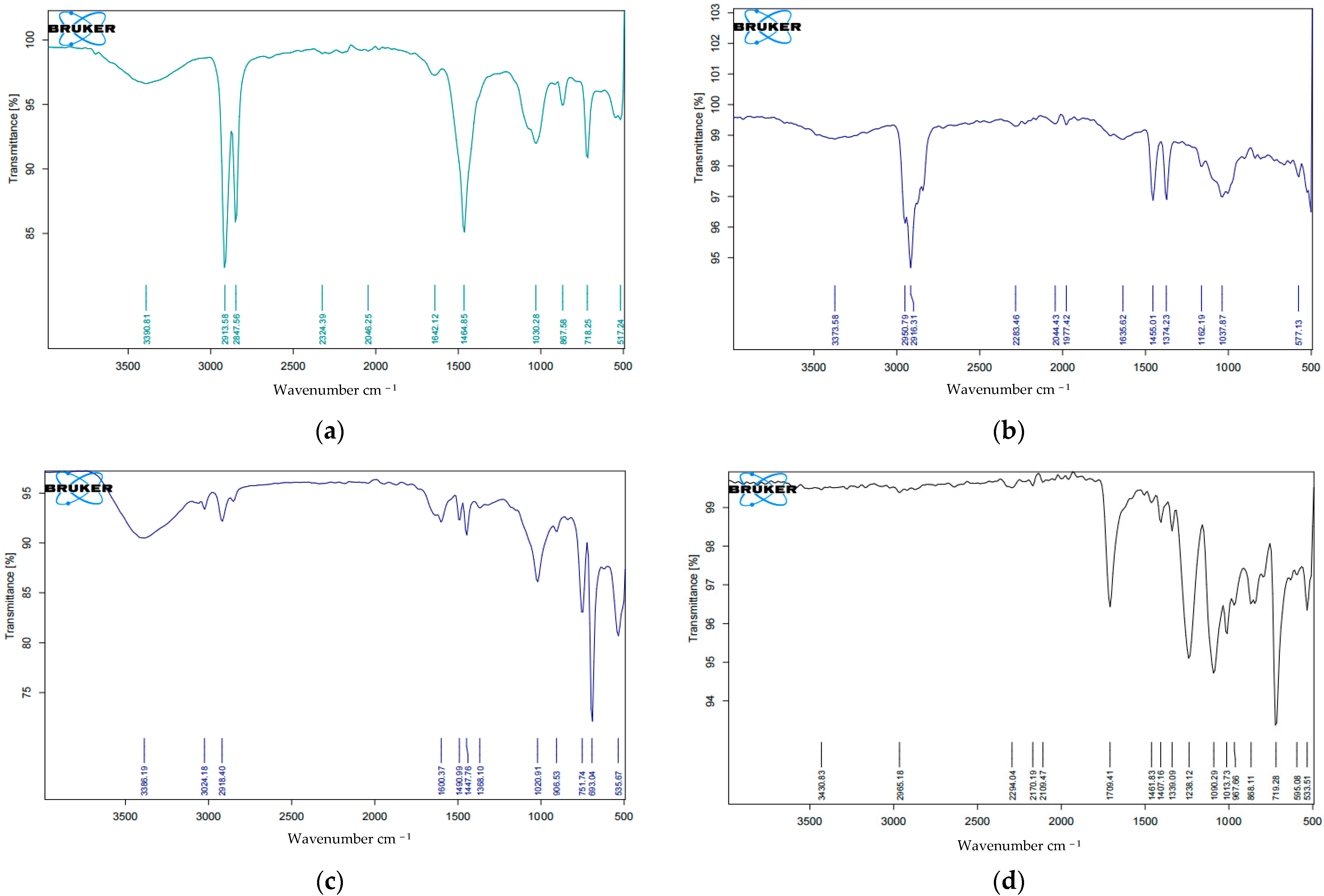Abundance, Distribution, and Characterization of Microplastics on Two Recreational Beaches in Kota Kinabalu, Sabah, Malaysia
Abstract
1. Introduction
2. Materials and Methods
2.1. Sampling Area
2.2. Sample Design and Data Collection
2.3. Quantification of Microplastics in Sediment
2.4. Microplastics Detection
2.5. Heavy Metal Analysis in Microplastics
3. Results and Discussion
3.1. Microplastics Abundance
3.2. Physical Characteristics of the Microplastics Found
3.3. Identification of Microplastics’ Polymer Composition
3.4. Heavy Metals Content in Microplastics
4. Conclusions
Author Contributions
Funding
Data Availability Statement
Acknowledgments
Conflicts of Interest
References
- Chen, H.L.; Nath, T.K.; Chong, S.; Foo, V.; Gibbins, C.; Lechner, A.M. The plastic waste problem in Malaysia: Management, recycling and disposal of local and global plastic waste. SN Appl. Sci. 2021, 3, 437. [Google Scholar] [CrossRef]
- Osman, A.I.; Hosny, M.; Eltaweil, A.S.; Omar, S.; Elgarahy, A.M.; Farghali, M.; Yap, P.S.; Wu, Y.S.; Nagandran, S.; Batumalaie, K.; et al. Microplastic sources, formation, toxicity and remediation: A review. Environ. Chem. Lett. 2023. [Google Scholar] [CrossRef]
- Lebreton, L.; Egger, M.; Slat, B. A global mass budget for positively buoyant macroplastic debris in the ocean. Sci. Rep. 2019, 9, 12922. [Google Scholar] [CrossRef]
- Napper, I.E.; Thompson, R.C. Plastic Debris in the Marine Environment: History and Future Challenges. Glob. Chall. 2020, 4, 1900081. [Google Scholar] [CrossRef]
- Smith, M.; Love, D.C.; Rochman, C.M.; Neff, R.A. Microplastics in Seafood and the Implications for Human Health. Curr. Environ. Health Rep. 2018, 5, 375. [Google Scholar] [CrossRef] [PubMed]
- Botterell, Z.L.R.; Beaumont, N.; Dorrington, T.; Steinke, M.; Thompson, R.C.; Lindeque, P.K. Bioavailability and effects of microplastics on marine zooplankton: A review. Environ. Pollut. 2019, 245, 98–110. [Google Scholar] [CrossRef]
- Van de Merwe, J.P.; Hodge, M.; Olszowy, H.A.; Whittier, J.M.; Ibrahim, K.; Lee, S.Y. Chemical contamination of green turtle (Chelonia mydas) eggs in peninsular Malaysia: Implications for conservation and public health. Environ. Health Perspect. 2009, 117, 1397–1401. [Google Scholar] [CrossRef] [PubMed]
- Sajjad, M.; Huang, Q.; Khan, S.; Khan, M.A.; Liu, Y.; Wang, J.; Lian, F.; Wang, Q.; Guo, G. Microplastics in the soil environment: A critical review. Environ. Technol. Innov. 2022, 27, 102408. [Google Scholar] [CrossRef]
- Zahari, N.Z.; Tuah, P.M.; Rahim, S.A. Inoculation of Bacillus cereus enhance phytoremediation efficiency of Pistia stratiotes and Eichhornia crassipes in removing heavy metal Pb. IOP Conf. Ser. Earth Environ. Sci. 2021, 847, 12012. [Google Scholar] [CrossRef]
- Zahari, N.Z.; Fong, N.S.; Cleophas, F.N.; Rahim, S.A. The Potential of Pistia stratiotes in the Phytoremediation of Selected Heavy Metals from Simulated Wastewater. Int. J. Technol. 2021, 12, 613–624. [Google Scholar] [CrossRef]
- Lu, L.; Wan, Z.; Luo, T.; Fu, Z.; Jin, Y. Polystyrene microplastics induce gut microbiota dysbiosis and hepatic lipid metabolism disorder in mice. Sci. Total. Environ. 2018, 631–632, 449–458. [Google Scholar] [CrossRef]
- Zahari, N.Z.; Baharudzaman, E.H.; Tuah, P.M.; Cleophas, F.N.; Vun, L.W. Characterization of polycyclic aromatic hydrocarbons and bioaugmentation potential of locally isolated beneficial microorganisms consortium for treatment of tar-balls. Environ. Nat. Resour. J. 2021, 19, 246–254. [Google Scholar] [CrossRef]
- Duncan, E.M.; Arrowsmith, J.; Bain, C.; Broderick, A.C.; Lee, J.; Metcalfe, K.; Pikesley, S.K.; Snape, R.T.; van Sebille, E.; Godley, B.J. The true depth of the Mediterranean plastic problem: Extreme microplastic pollution on marine turtle nesting beaches in Cyprus. Mar. Pollut. Bull. 2018, 136, 334–340. [Google Scholar] [CrossRef]
- A National Ban on Turtle Egg Sales and Consumption Needed|WWF Malaysia. Available online: https://www.wwf.org.my/?20545/A-national-ban-on-turtle-egg-sales-and-consumption-needed (accessed on 31 March 2023).
- Thiessen, T. Borneo: Sabah; Brunei, Sarawak; The Bradt Travel Guide: Chesham, UK, 2008; 312p. [Google Scholar]
- About Sabah|The Borneo Expedition—Experience Borneo Like Never Before. Available online: https://www.theborneoexpedition.com/about-sabah/ (accessed on 31 March 2023).
- Why Tanjung Aru Is Kota Kinabalu’s Most Popular Beach|Sabah, North Borneo. Available online: https://www.sabahtourism.com/article/why-tanjung-aru-is-kota-kinabalus-most-popular-beach/?locale=en (accessed on 31 March 2023).
- Outdoor Development Centre (ODEC). Available online: https://www.ums.edu.my/pkppv2/index.php/en/facilities/outdoor-development-centre-odec (accessed on 31 March 2023).
- Zahari, N.Z.; Tuah, P.M.; Junaidi, M.R.; Ali, S.A.M. Identification; Abundance, and Chemical Characterization of Macro-, Meso-, and Microplastics in the Intertidal Zone Sediments of Two Selected Beaches in Sabah, Malaysia. Water 2022, 14, 1600. [Google Scholar] [CrossRef]
- Gelhardt, L.; Kuch, B.; Dittmer, U.; Welker, A. Granulometric distribution of metals in road-deposited sediments by using different sieving methods. Environ. Adv. 2021, 5, 100094. [Google Scholar] [CrossRef]
- Razeghi, N.; Hamidian, A.H.; Wu, C.; Zhang, Y.; Yang, M. Microplastic sampling techniques in freshwaters and sediments: A review. Environ. Chem. Lett. 2021, 19, 4225. [Google Scholar] [CrossRef] [PubMed]
- Dalvand, M.; Hamidian, A.H. Occurrence and distribution of microplastics in wetlands. Sci. Total Environ. 2023, 862, 160740. [Google Scholar] [CrossRef]
- Mel, C.; Gabriel, B.; Noemie, B.; Claire, A. Extraction of microplastics from sediment matrices: Experimental comparative analysis. J. Hazard. Mater. 2021, 420, 126571. [Google Scholar] [CrossRef]
- Alfaro-Núñez, A.; Astorga, D.; Cáceres-Farías, L.; Bastidas, L.; Soto Villegas, C.; Macay, K.; Christensen, J.H. Microplastic pollution in seawater and marine organisms across the Tropical Eastern Pacific and Galápagos. Sci. Rep. 2021, 11, 6424. [Google Scholar] [CrossRef]
- Free, C.M.; Jensen, O.P.; Mason, S.A.; Eriksen, M.; Williamson, N.J.; Boldgiv, B. High-levels of microplastic pollution in a large, remote, mountain lake. Mar. Pollut. Bull. 2014, 85, 156–163. [Google Scholar] [CrossRef]
- Campanale, C.; Massarelli, C.; Bagnuolo, G.; Savino, I.; Uricchio, V.F. The Problem of Microplastics and Regulatory Strategies in Italy. Handb. Environ. Chem. 2022, 112, 255–276. [Google Scholar] [CrossRef]
- Sakurai, H.; Noro, J.; Kawase, A.; Fujinami, M.; Oguma, K. Digestion of plastic materials for the determination of toxic metals with a microwave oven for household use. Anal. Sci. 2006, 22, 225–228. [Google Scholar] [CrossRef] [PubMed]
- Fauziah, S.H.; Liyana, I.A.; Agamuthu, P. Plastic debris in the coastal environment: The invincible threat? Abundance of buried plastic debris on Malaysian beaches. Waste Manag. Res. 2015, 33, 812–821. [Google Scholar] [CrossRef] [PubMed]
- Lenaker, P.L.; Corsi, S.R.; Mason, S.A. Spatial Distribution of Microplastics in Surficial Benthic Sediment of Lake Michigan and Lake Erie. Environ. Sci. Technol. 2021, 55, 373–384. [Google Scholar] [CrossRef]
- Yuan, Z.; Nag, R.; Cummins, E. Human health concerns regarding microplastics in the aquatic environment—From marine to food systems. Sci. Total. Environ. 2022, 823, 153730. [Google Scholar] [CrossRef] [PubMed]
- Stolte, A.; Forster, S.; Gerdts, G.; Schubert, H. Microplastic concentrations in beach sediments along the German Baltic coast. Mar. Pollut. Bull. 2015, 99, 216–229. [Google Scholar] [CrossRef]
- Imhof, H.K.; Rusek, J.; Thiel, M.; Wolinska, J.; Laforsch, C. Do microplastic particles affect Daphnia magna at the morphological, life history and molecular level? PLoS ONE 2017, 12, e0187590. [Google Scholar] [CrossRef]
- Piñon-Colin, T.D.J.; Rodriguez-Jimenez, R.; Pastrana-Corral, M.A.; Rogel-Hernandez, E.; Wakida, F.T. Microplastics on sandy beaches of the Baja California Peninsula, Mexico. Mar. Pollut. Bull. 2018, 131 Pt A, 63–71. [Google Scholar] [CrossRef]
- Kiran, B.R.; Kopperi, H.; Mohan, S.V. Micro/nano-plastics occurrence; identification; risk analysis and mitigation: Challenges; perspectives. Rev. Environ. Sci. Biotechnol. 2022, 21, 169–203. [Google Scholar] [CrossRef]
- Zahari, N.Z.; Rafidi, F.J.; Cleophas, F.N.; Budin, K.; Musta, B. Distribution and Abundance of Marine Debris on Intertidal Zone at Three Selected Small Islands, Sabah. J. Phys. Conf. Ser. 2022, 2314, 12001. [Google Scholar] [CrossRef]
- Dey, S.; Rout, A.K.; Behera, B.K.; Ghosh, K. Plastisphere community assemblage of aquatic environment: Plastic-microbe interaction, role in degradation and characterization technologies. Environ. Microbiome 2022, 17, 32. [Google Scholar] [CrossRef] [PubMed]
- Prata, J.C. Airborne microplastics: Consequences to human health? Environ. Pollut. 2018, 234, 115–126. [Google Scholar] [CrossRef] [PubMed]
- Akanyange, S.N.; Zhang, Y.; Zhao, X.; Adom-Asamoah, G.; Ature, A.R.; Anning, C.; Tianpeng, C.; Zhao, H.; Lyu, X.; Crittenden, J.C. A holistic assessment of microplastic ubiquitousness: Pathway for source identification in the environment. Sustain. Prod. Consum. 2022, 33, 113–145. [Google Scholar] [CrossRef]
- Noik, V.J.; Tuah, P.M. A first survey on the abundance of plastics fragments and particles on two sandy beaches in Kuching, Sarawak, Malaysia. IOP Conf. Ser. Mater. Sci. Eng. 2015, 78, 12035. [Google Scholar] [CrossRef]
- Pironti, C.; Ricciardi, M.; Motta, O.; Miele, Y.; Proto, A.; Montano, L. Microplastics in the Environment: Intake through the Food Web, Human Exposure and Toxicological Effects. Toxics 2021, 9, 224. [Google Scholar] [CrossRef] [PubMed]
- Andrady, A.L. Persistence of Plastic Litter in the Oceans. In Marine Anthropogenic Litter; Springer: Berlin/Heidelberg, Germany, 2015; pp. 57–72. [Google Scholar] [CrossRef]
- Erni-Cassola, G.; Zadjelovic, V.; Gibson, M.I.; Christie-Oleza, J.A. Distribution of plastic polymer types in the marine environment; A meta-analysis. J. Hazard. Mater. 2019, 369, 691–698. [Google Scholar] [CrossRef]
- De Haan, W.P.; Sanchez-Vidal, A.; Canals, M. Floating microplastics and aggregate formation in the Western Mediterranean Sea. Mar. Pollut. Bull. 2019, 140, 523–535. [Google Scholar] [CrossRef]
- Uurasjärvi, E.; Hartikainen, S.; Setälä, O.; Lehtiniemi, M.; Koistinen, A. Microplastic concentrations; size distribution, and polymer types in the surface waters of a northern European lake. Water Environ. Res. 2020, 92, 149. [Google Scholar] [CrossRef]
- Geyer, R.; Jambeck, J.R.; Law, K.L. Production, use, and fate of all plastics ever made. Sci. Adv. 2017, 3, e1700782. [Google Scholar] [CrossRef]
- Liu, S.; Shi, J.; Wang, J.; Dai, Y.; Li, H.; Li, J.; Liu, X.; Chen, X.; Wang, Z.; Zhang, P. Interactions Between Microplastics and Heavy Metals in Aquatic Environments: A Review. Front. Microbiol. 2021, 12, 652520. [Google Scholar] [CrossRef]
- Thushari, G.G.N.; Senevirathna, J.D.M. Plastic pollution in the marine environment. Heliyon 2020, 6, e04709. [Google Scholar] [CrossRef] [PubMed]
- Rodrigues, J.P.; Duarte, A.C.; Santos-Echeandía, J. Interaction of microplastics with metal(oid)s in aquatic environments: What is done so far? J. Hazard. Mater. Adv. 2022, 6, 100072. [Google Scholar] [CrossRef]
- Munier, B.; Bendell, L.I. Macro and micro plastics sorb and desorb metals and act as a point source of trace metals to coastal ecosystems. PLoS ONE 2018, 13, e0191759. [Google Scholar] [CrossRef]
- Li, W.; Lo, H.S.; Wong, H.M.; Zhou, M.; Wong, C.Y.; Tam, N.F.; Cheung, S.G. Heavy metals contamination of sedimentary microplastics in Hong Kong. Mar. Pollut. Bull. 2020, 153, 110977. [Google Scholar] [CrossRef] [PubMed]
- Chamas, A.; Chamas, A.; Moon, H.; Zheng, J.; Qiu, Y.; Tabassum, T.; Jang, J.H.; Abu-Omar, M.; Scott, S.L.; Suh, S. Degradation Rates of Plastics in the Environment. ACS Sustain. Chem. Eng. 2020, 8, 3494–3511. [Google Scholar] [CrossRef]
- Lu, K.; Qiao, R.; An, H.; Zhang, Y. Influence of microplastics on the accumulation and chronic toxic effects of cadmium in zebrafish (Danio rerio). Chemosphere 2018, 202, 514–520. [Google Scholar] [CrossRef]
- Tunali, M.; Uzoefuna, E.N.; Tunali, M.M.; Yenigun, O. Effect of microplastics and microplastic-metal combinations on growth and chlorophyll a concentration of Chlorella vulgaris. Sci. Total. Environ. 2020, 743, 140479. [Google Scholar] [CrossRef]
- Akhbarizadeh, R.; Dobaradaran, S.; Nabipour, I.; Tajbakhsh, S.; Darabi, A.H.; Spitz, J. Abundance; composition, and potential intake of microplastics in canned fish. Mar. Pollut. Bull. 2020, 160, 111633. [Google Scholar] [CrossRef]







| Sampling Sites | Type of Beach | Total Abundance of MPs/kg Dry Sediment | Total Mass Concentration (g/kg) | Total Number of MPs/kg Dry Sediment | |||||||
|---|---|---|---|---|---|---|---|---|---|---|---|
| Station 1 | Total Mass Concentration (g/kg) | Station 2 | Total Mass Concentration (g/kg) | Station 3 | |||||||
| Nov | Dec | Nov | Dec | Nov | Dec | ||||||
| Tanjung Aru Beach | Recreational (open beach) | 352 | 56 | 22.76 | 188 | 115 | 23.65 | 75 | 71 | 11.31 | 857 |
| UMS ODEC Beach | Recreational (private beach) | 22 | 26 | 1.70 | 34 | 28 | 8.82 | 33 | 17 | 7.44 | 160 |
Disclaimer/Publisher’s Note: The statements, opinions and data contained in all publications are solely those of the individual author(s) and contributor(s) and not of MDPI and/or the editor(s). MDPI and/or the editor(s) disclaim responsibility for any injury to people or property resulting from any ideas, methods, instructions or products referred to in the content. |
© 2023 by the authors. Licensee MDPI, Basel, Switzerland. This article is an open access article distributed under the terms and conditions of the Creative Commons Attribution (CC BY) license (https://creativecommons.org/licenses/by/4.0/).
Share and Cite
Zahari, N.Z.; Vincent, S.D.; Cleophas, F.N.; Budin, K.; Sabullah, M.K. Abundance, Distribution, and Characterization of Microplastics on Two Recreational Beaches in Kota Kinabalu, Sabah, Malaysia. Water 2023, 15, 2681. https://doi.org/10.3390/w15152681
Zahari NZ, Vincent SD, Cleophas FN, Budin K, Sabullah MK. Abundance, Distribution, and Characterization of Microplastics on Two Recreational Beaches in Kota Kinabalu, Sabah, Malaysia. Water. 2023; 15(15):2681. https://doi.org/10.3390/w15152681
Chicago/Turabian StyleZahari, Nur Zaida, Sharmila Devi Vincent, Fera Nony Cleophas, Kamsia Budin, and Mohd Khalizan Sabullah. 2023. "Abundance, Distribution, and Characterization of Microplastics on Two Recreational Beaches in Kota Kinabalu, Sabah, Malaysia" Water 15, no. 15: 2681. https://doi.org/10.3390/w15152681
APA StyleZahari, N. Z., Vincent, S. D., Cleophas, F. N., Budin, K., & Sabullah, M. K. (2023). Abundance, Distribution, and Characterization of Microplastics on Two Recreational Beaches in Kota Kinabalu, Sabah, Malaysia. Water, 15(15), 2681. https://doi.org/10.3390/w15152681







